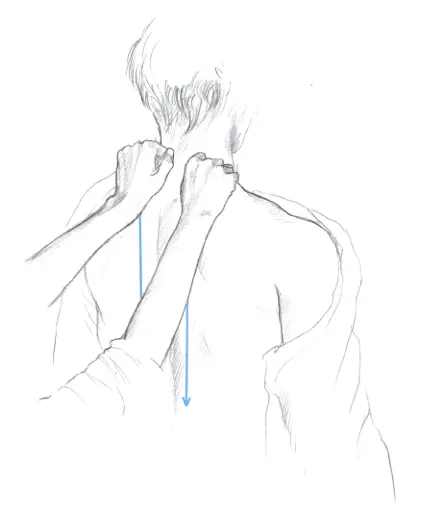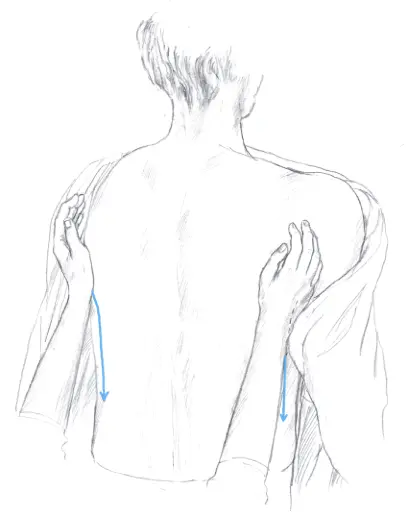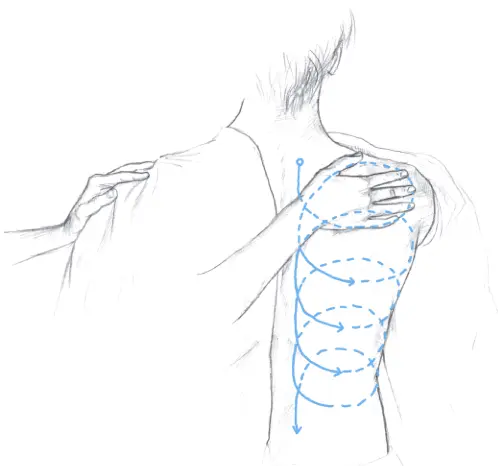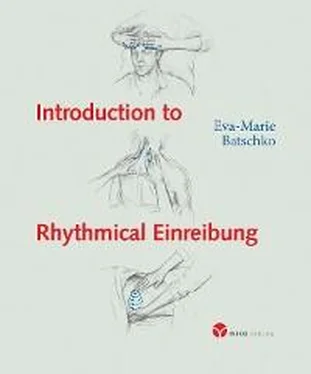Then the right hand covers the left hand and spreads the oil on the palms with a single stroke.
Only touch the patient with warm hands! The hands should be soft, supple and empathetic!
7. Outer posture of the practitioner
Stand freely (without leaning against or supporting yourself with anything). Flexible stance, slightly open towards the massage table, with loose, slightly bent knees.
Spread your weight evenly on both feet, with a slight, elastic flexion of the back to allow for inner resonance and free movement of the shoulders and arms (but do not bow!).
Distance to the patient neither too close (‘nose on the stomach’) nor too distant (‘head and back stretched backwards’) – this applies both physically and mentally.
Keep returning to an upright posture to connect with the cosmos that is radiating in from behind.
Movements are initiated between the should blades from the space at the back – the shoulder girdle and arms harmonise with the movement.
8. Inner attitude of the practitioner
‘There is only one temple in the world, and that is the human body. Nothing is more holy than this high form. Bowing before human beings is homage to this revelation in the flesh... We touch heaven when we feel a human body. ‘ (3)
Warm interest in and concern for the individual person (attentiveness). Being able to put oneself in second place (disregard of how we ourselves feel). ‘Control’ of thoughts and feelings. Inner calm and concentration during treatment (keeping ourselves centred).
Outward silence during treatment – conversation between hands and body (e.g. in the back Einreibung: ‘Speaking hands and listening back’ as well as ‘Listening hands and speaking back’).
Perception of the patient with all the senses (cultivate eye contact with the patient's countenance).
Connecting in awareness of a common sphere (awareness of surroundings).
Healer’s courage.
Do not forget humour – it helps you to ease difficult situations.
9. Archetypal image of Rhythmical Einreibung
‘The predisposition for the heart is created at the point where the blood can no longer continue to flow, is halted and dammed up; that is, the blood arrives and is brought to rest in being dammed up at, or rather on the head pole to form the heart. Since it cannot continue and has stopped, it reverses and travels back the way it has come along other capillaries. It disappears into the periphery where it originated, renews itself and starts on its way again from the beginning. All this means that, as described by morphodynamics, the conditions in the embryo are reversed.’(4)
This representation of heart development in the embryo describes the archetype of Rhythmical Einreibung.
Coming from the periphery, I dip into and gather the tissue, engaging it.
At the peak of this engagement I pause a little and let the movement continue to flow inwardly until it transforms itself into a release.
Through this greatest outward engagement, a supporting ‘gesture of levity’ is created inwardly.
This pause resembles the gesture of damming up in heart development where stillness and reversal simultaneously culminate.
Newly revived through the current reversed at the periphery, I release my hand from the engagement.
I let the return current quietly fade away into the periphery.
Thus in engagement there is an inhalation as far as an inner moment of reversal, followed in release by an exhalation as far as an outer moment of reversal.
These moments of reversal separate the two opposing currents from one another and simultaneously connect them.
In damming up and pausing, an organ is formed in the etheric that can have a healing effect on the living organism.
Further information on treatment can be found in the chapter ‘Questions and answers about Rhythmical Einreibung’.
The treatment positions are always described from the position of the patient.
In the drawings, ‘engagement’ is expressed by continuous lines while ‘release’ is represented by broken lines.
Einreibung of the back while sitting
The patient sits upright on the massage table or a chair; the feet rest on a solid support (e.g. a stool or the floor).
A pillow (possibly two) lies on the thighs covered with a towel; the underarms rest on it, slightly angled, so that the shoulders are relaxed and an upright posture is supported.
The entire upper body (including arms and hands) is wrapped in a blanket, the ends of which overlap behind the back.
For uncovering the back, the two ends are opened up to the left and/or right so that they hang loosely to one side, with the shoulder joints remaining covered.
1. Downstroke on the back
Standing behind the patient, I initiate the downstroke simultaneously with the heels of both hands directly to the left and right of the seventh vertebra (Vertebra prominens).

Ill. 1
Then I dip both hands – fingers pointing towards the head – lightly into the tissue and then stroke downwards along the back, parallel to the spine.
At the lower end of the back I release first the heel of the hands, then the middle of the hands and finally the finger pads from contact with the skin (without bowing forwards!).
I now hold the collected warmth lightly enclosed on the inside of my hands.
With this gesture, I return my hands to the starting point below the scapulae with a slight arc in the air, in order there to open both hands again after dipping in with the heels of the hands.
In this way the flow of warmth is not interrupted.
In the downstroke on the back, my left hand always flows to the left of the spine, the right hand to the right.

Ill. 2

Ill. 3
This is done in three different, parallel movement flows, moving progressively further away from the spine laterally to the outside:
Stroke 1 moves inside close to the spine (but not touching it!).
Stroke 2 begins a hand’s width further outwards.
Stroke 3 moves so far out at the height of the armpits that the patient's sides are also touched. My hands always remain in flow and glide lightly following the shape of the body. In this dynamic they gradually turn a crescendo into a decrescendo.
EFFECT
The parallel nature of the back downstroke acts in a clarifying and ordering way, bringing about the perception of our own back.
The downward-flowing current of the hands creates a feeling of wanting to adopt an upright posture.
INDICATIONS
Acute life crises; psychophysical exhaustion; postural disorders; scoliosis; lordosis; kyphosis; apoplexy; paraplegia; obesity.
NOTE
The back downstroke is repeated, at most, three times, and only at the beginning of a back Einreibung.
2. One-handed circles on the back
Standing to the left of the patient, I first treat the right half of the back, then the left. The half of the back not in treatment is covered with a towel.

Ill. 4
While my right hand lightly describes counterclockwise circles, my left hand rests on the patient’s left shoulder. With the heel of the right hand I initiate the movement to the right of the seventh cervical vertebra (Vertebra prominens) and then slide, with the hand relaxed and with full skin contact, into the first circular form: my fingers follow the costal arch, such that the hand does not point horizontally to the side but rather slopes slightly downwards. In the first circular form, my hand creates an envelope as it swings warmly and softly around the shoulder joint, including it in the treatment. On the spine, down the erector spinae muscle, I dip with renewed emphasis into the downward movement and release again with the next circle.
Читать дальше







![Andrew Radford - Linguistics An Introduction [Second Edition]](/books/397851/andrew-radford-linguistics-an-introduction-second-thumb.webp)








